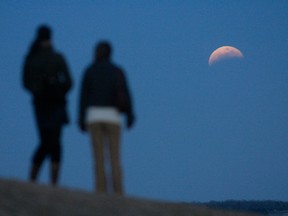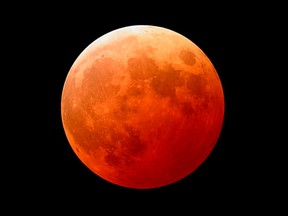Lunar eclipses, also known as ‘blood moons,’ occur twice a year on average. But this is an exact replica of one not seen since 1504
Article content
Late Thursday night and into Friday morning, Canadians under clear skies will be able to watch a lunar eclipse, as the moon gets covered by the shadow of the Earth and turns a dark, smoky reddish-brown for a little over an hour. Here’s what to know about this celestial event, also known as a “blood moon” for its colour.
Article content
Article content
What is a lunar eclipse?
A lunar eclipse is what happens when the shadow of the Earth falls on the moon. It’s similar to a solar eclipse, when the moon comes between the sun and casts a shadow on the the Earth, but in this case the Earth is in the middle.
Advertisement 2
Article content
How often do they happen?
Like solar eclipses, lunar eclipses happen twice a year on average. But while the shadow of a solar eclipse is only visible from a narrow strip of the Earth’s surface, a lunar eclipse can be viewed by half the planet. This time, that includes all of North America. (The moon’s orbit is tilted a little compared to the Earth; if it weren’t, there would be a lunar eclipse once a month, every time there was a full moon.)
Do I need special equipment to view it?
Nope! Binoculars or a telescope can give you a closer view of the moon’s surface, but all you really need to do it look up at the moon during the eclipse, and watch its brightness fade to its “blood moon” dusky red.

What gives the moon that colour?
The Earth’s atmosphere is the reason. If the Earth had no air, its shadow would make the moon turn black and disappear completely in the night sky. But our atmosphere scatters some of the sunlight that hits our planet. Blue light scatters faster, which means the light that reaches the moon is on the red end of the spectrum.
Or to quote NASA in a rare moment of poetic description: “It’s as if all the world’s sunrises and sunsets are projected onto the Moon.”
Article content
Advertisement 3
Article content
When will it happen?
The eclipse begins at 11:57 p.m. ET Thursday night, as the edge of the Earth’s shadow first touches the moon. A little more than an hour later, the main part of the Earth’s shadow starts to cover the moon, and by 2:26 a.m. the moon is completely in the shadow of our planet.
A little over an hour after that, the moon starts to emerge, and by 6 a.m. it’s back to its usual bright colour. Canadians on the west coast will have an easier time watching, as the show begins at 8:57 p.m. there.
What’s the Columbus connection?
Eclipses are cyclical events, meaning that astronomers can predict them hundreds of years into the future (and the past for that matter). In 1504, the explorer Christopher Columbus was stranded in Jamaica and awaiting rescue. The local people there were tired of provisioning him and his crew with food, but Columbus had an ace up his sleeve — an astronomical chart that indicated a total lunar eclipse on Feb. 29 (leap day) that year.
Columbus told the Jamaicans that his God was angry at them and would turn the moon red that night. To really drive the point home, he pretended to pray for an hour during the eclipse, after which the redness vanished. The Jamaicans decided to keep giving him food until his rescue.
Advertisement 4
Article content
Eclipses follow a cycle that repeats about every 18 years, called the Saros cycle. But there is a longer cycle, the Hypersaros, which means that every 521 years an almost identical eclipse will occur. This year’s eclipse is an exact copy (same part of the sky, same timing) as the one Columbus saw in 1504. The next repeat of that precise eclipse will be in the year 2546.

What if I miss it?
If you miss this one and you don’t want the “Columbus special,” you won’t need to wait another 521 years. The next eclipse visible from North America (technically it’s a partial lunar eclipse, but very close to a total one) will be on the night of Aug. 26, 2026.
Have we ever seen a lunar eclipse from the moon?
Humans have never witnessed a lunar eclipse from the moon’s surface, but in 1971 instruments left behind by the Apollo astronauts recorded that the moon’s surface temperature plummeted from about 70 degrees C to 100 below during the eclipse.
Four years before that, the unmanned Surveyor 3 probe snapped some grainy images of an eclipse from the moon’s surface. And if all goes well, the Blue Ghost lander, which touched down on the moon earlier this month, will get some much sharper pictures of this week’s eclipse.

Recommended from Editorial
Our website is the place for the latest breaking news, exclusive scoops, longreads and provocative commentary. Please bookmark nationalpost.com and sign up for our newsletters here.
Article content









